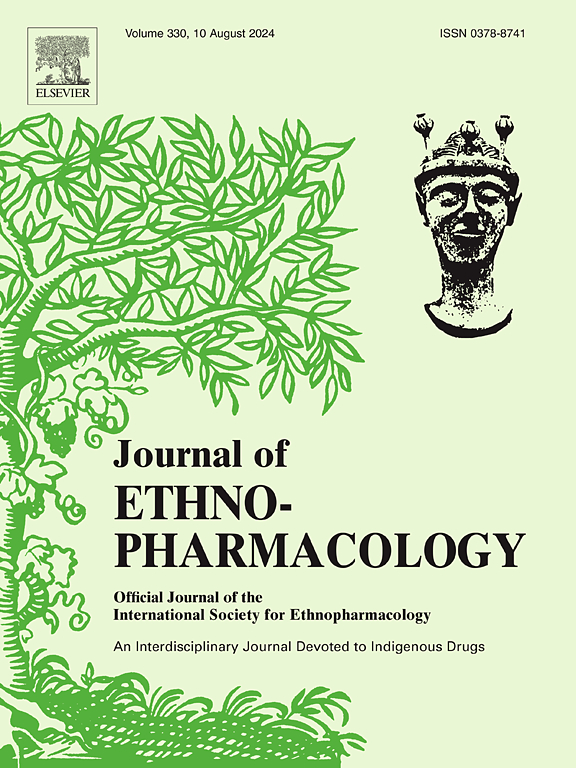红树的民族药理学与治疗前景的桥梁
IF 5.4
2区 医学
Q1 CHEMISTRY, MEDICINAL
引用次数: 0
摘要
黄花红树(excoecaria agallocha L.),俗称“盲眼红树”或“乳红树”,是一种丰富的红树物种,广泛分布在亚洲、东非、澳大利亚和太平洋地区的热带和温带沿海地区。从古代开始,这种植物的几种制剂就被用于治疗许多健康疾病,包括癫痫、溃疡、牙痛、伤口、麻风病、结膜炎、麻痹、皮炎、蚊媒疾病等,这使得这种植物成为进一步广泛研究的重要候选植物。综述目的通过对现有文献和最新发表文献的评价,对沉香叶的全球分布、形态特征、民族药理学、不同溶剂提取物的药理活性和生物活性成分进行综合评价,为有效利用沉香叶及其分离成分进行前瞻性研究提供依据。因此,这将有助于进一步的植物和植物化学研究,从而导致未来的新药物的发现和已经建立的生物活性的验证和实施。资料与方法为了获得本综述的相关资料,对谷歌Scholar、Web of Science、PubMed、SCOPUS等文献资源进行了全面检索。从GBIF和印度生物多样性门户等网站获得同义词、分类和全球分布数据。此外,使用ChemBio Draw Ultra 14.0生成化学结构,并使用PubChem验证了发现的次级代谢物的IUPAC名称。结果经综合植物化学研究,鉴定出至少235种不同结构类别的植物成分,包括生物碱、二萜、类黄酮、有机脂肪酸、酚酸、甾醇、单宁、三萜和其他杂类化合物。在一些体外和体内研究中,agallocha L.还显示出多种突出的药理和生物活性,如抗菌、抗氧化、抗炎、镇痛、抗癌、抗糖尿病、抗惊厥、抗溃疡、抗胶原酶、非特异性免疫、镇静、抗组胺释放、抗弹性酶和抑制hedgehog信号传导特性。结论沉香露表皮菌具有广谱的药理活性,这是通过深入的体内外实验得出的结论。它的植物化学多样性反映了它作为生物活性实体的丰富来源的巨大效用。由于其具有多谱治疗活性,因此在新药开发方面具有很大的潜力。但要使其完全成为一种药物,还需要更多以生物测定为指导的调查,并辅以广泛的临床和毒理学研究。目前的研究结果需要进一步研究,以开发安全有效的治疗药物。本文章由计算机程序翻译,如有差异,请以英文原文为准。

Excoecaria agallocha L.: Bridging ethnopharmacology and therapeutic promises of a healing mangrove
Ethnopharmacological relevance
Excoecaria agallocha L., popularly known as ‘Blind-your-eye mangrove’ or ‘Milky-mangrove’, is a substantial mangrove species abundantly distributed around the coastal areas of the tropical and temperate zones of Asia, East Africa, Australia, and the Pacific regions. Several preparations from this plant have been used to treat numerous health disorders, both in preventive and curative measures, from ancient times, including epilepsy, ulcer, toothache, wound, leprosy, conjunctivitis, paralysis, dermatitis, mosquito-borne disease etc., which makes this plant a great candidate for further extensive research.
Aim of review
The key objective of this review is to assemble a comprehensive index of global distribution, morphological characteristics, ethnopharmacology, pharmacological activities of different solvent extracts and bioactive constituents of E. agallocha with the evaluation of remaining and the latest published literatures, which may guide in prospective research studies for the effective implementation of this plant extract and its isolated constituents in medical aspects. Thus, this compilation will be very helpful to the researchers for further botanical and phytochemical studies leading to future novel drug discovery and in the validation and implementation of the already established bioactivities.
Materials & methods
Bibliographic resources, including Google Scholar, Web of Science, PubMed, SCOPUS, and others, were thoroughly searched in order to get relevant material for this review on Excoecaria agallocha. Synonyms, taxonomy, and worldwide distribution data were obtained from websites such as GBIF and the India Biodiversity Portal. Furthermore, chemical structures were produced using ChemBio Draw Ultra 14.0, and the IUPAC names of the secondary metabolites that were found were verified using PubChem.
Results
Comprehensive phytochemical studies on various parts of E. agallocha have identified at least 235 phytoconstituents across diverse structural classes, including alkaloid, diterpenoids, flavonoids, organic fatty acids, phenolic acids, sterols, tannins, triterpenoids, and other miscellaneous compounds. Excoecaria agallocha L. also exhibits various prominent pharmacological and bioactivities like antimicrobial, antioxidant, anti-inflammatory, analgesic, anticancer, anti-diabetic, anti-convulsant, anti-ulcer, anti-collagenase, non-specific immunity, sedative, anti-histamine release, anti-elastase, and hedgehog signaling inhibiting properties evident from several in vitro and in vivo research.
Conclusion
Excoecaria agallocha L. exhibits a broad spectrum of pharmacological activities, as inferred from thorough in vitro and in vivo studies. Its phytochemical diversity mirrors its enormous utility as a rich source of bioactive entities. With its multi-spectrum therapeutic activity, E. agallocha holds high potential for the discovery of new drugs. But for its complete exploitation as a drug, more bioassay-guided investigation, complemented by extensive clinical and toxicological studies, is needed. The present findings demand further research aimed at the development of safe and effective therapeutic drugs from this mangrove species.
求助全文
通过发布文献求助,成功后即可免费获取论文全文。
去求助
来源期刊

Journal of ethnopharmacology
医学-全科医学与补充医学
CiteScore
10.30
自引率
5.60%
发文量
967
审稿时长
77 days
期刊介绍:
The Journal of Ethnopharmacology is dedicated to the exchange of information and understandings about people''s use of plants, fungi, animals, microorganisms and minerals and their biological and pharmacological effects based on the principles established through international conventions. Early people confronted with illness and disease, discovered a wealth of useful therapeutic agents in the plant and animal kingdoms. The empirical knowledge of these medicinal substances and their toxic potential was passed on by oral tradition and sometimes recorded in herbals and other texts on materia medica. Many valuable drugs of today (e.g., atropine, ephedrine, tubocurarine, digoxin, reserpine) came into use through the study of indigenous remedies. Chemists continue to use plant-derived drugs (e.g., morphine, taxol, physostigmine, quinidine, emetine) as prototypes in their attempts to develop more effective and less toxic medicinals.
 求助内容:
求助内容: 应助结果提醒方式:
应助结果提醒方式:


